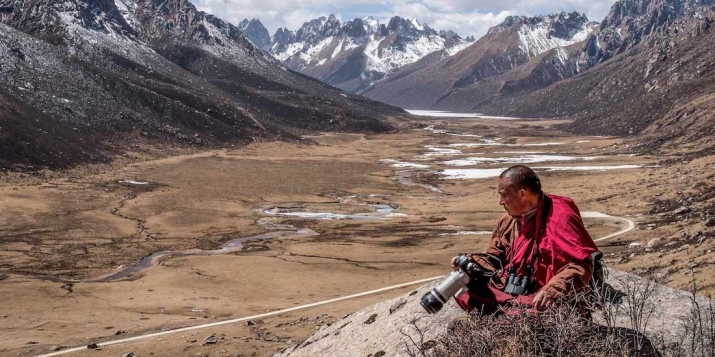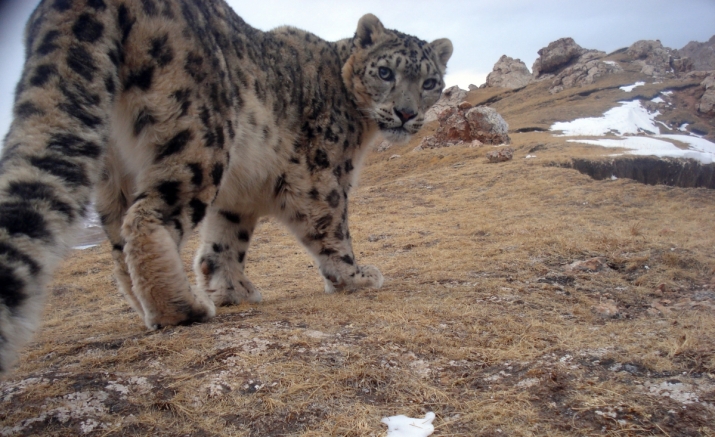NEWS
Buddhist Monk Highlights Need for Conservation on the Tibetan Plateau
 Ven. Drukyab waits with his camera, scanning the mountainside for wild animals. Photo by Luc Forsyth. From sixthtone.com
Ven. Drukyab waits with his camera, scanning the mountainside for wild animals. Photo by Luc Forsyth. From sixthtone.comThe Tibetan Plateau is home to some of the world’s rarest wild species, among them the elusive snow leopard. With estimates for the total global population ranging from 3,920–6,390 in the wild, snow leopards are classified as endangered on the IUCN Red List of Threatened Species.* In recent years, however, an unlikely wildlife activist has embarked on a self-imposed mission to record the declining biodiversity of the Tibetan Plateau. The Buddhist monk, who comes from a traditional Tibetan nomadic community and goes by the name Drukyab, travels through the Himalayas documenting the snow leopard, along with other other flora and fauna in the remote region, seeking to raise awareness about threats to the region’s delicate ecological balance.
Besides being a senior Buddhist monk, Venerable Drukyab is also a photographer, filmmaker, environmental activist, amateur biologist, anthropologist, botanist, and zoologist. He has worked with BBC documenting Tibet’s natural environment and his four-year study of the Tibetan bunting, a rare bird found around Nyanpo Yurtse Mountain only, was published in the Chinese Journal of Zoology.
Venerable Drukyab says he feels a strong connection with the animals he documents, explaining how the turning point in his life came when, as a child, he was unable to save the life of a gazelle fawn whose mother had been killed by a group of Chinese hunters: “I went back for three days in a row to try and help its baby, but I couldn’t, and it died. After that, I decided to stop hunting and become a monk.” At the age of 13, he left his family behind to seek monastic ordination. (The Sixth Tone)
As a monk, his daily routine begins with the typical Tibetan monastic rituals, including chanting Buddhist scriptures, before he sets out to comprehensively document and catalogue Tibet’s flora and fauna. Venerable Drukyab remains committed to his resolve that, with the help of modern technology, he can demonstrate to the world why Tibet’s ecology is worth protecting.
In an October 2016 interview with journalists from the documentary project A River’s Tale, the 47-year-old monk explained how he bought his first camera, without any proper training, before going on to produce the kind of wildlife photography that many professional photographers spend months in the wild trying to capture—often unsuccessfully. “In the beginning I had no money. I had to borrow [money] from my family for a digital camera and lens. Even then, I didn’t really know how to use it,” he recalled. (A River’s Tail)
Recounting the first time he set out in search of snow leopards to photograph, Ven. Drukyab related how he ventured into the mountains with just a simple jacket over his monastic robes to stave off the Himalayan cold. After two weeks of observing the same spot, his patience paid off when he sighted a herd of sheep fleeing down the mountainside. He soon realized this was the moment he had been waiting for—the secretive snow leopard on the hunt.
As the dramatic event unfolded just meters from where he waited, his compassion and vows as a Buddhist monk compelled him to put aside his camera and save the sheep from the great hunter rather than capture the image he had worked so hard to pursue. “But I don’t regret not taking the picture,” Ven. Drukyab noted.
Since that fateful encounter, Ven. Drukyab has come into close contact with snow leopards on several occasions, which he has successfully captured with his camera. (A River’s Tail)
The senior monk lamented the lack of scientific research in the region. “In Tibet there is a problem with science and tradition. Science isn't arriving fast enough and traditions are disappearing. We need science to arrive so it can mix with tradition and culture before it’s gone.” He also expressed sadness over the reactions he sometimes receives from Chinese tourists when he explains to them about the region’s delicate natural environment and rare wild animals. According to Venerable Drukyab, their first questions are often “are the animals delicious?” and “why isn’t the mountain being mined yet?” (A River’s Tale)
 A snow leopard captured by a camera trap on the Tibetan Plateau. From cnn.com.
A snow leopard captured by a camera trap on the Tibetan Plateau. From cnn.com.It has been 10 years since Venerable Drukyab embarked on the path of photographer and conservationist, yet despite witnessing a general decline in biodiversity, he remains optimistic: “I have always had a strong connection with animals, and now it is my turn to give something back to them,” he says. “My only wish is for people who understand environmental issues to do what they can to protect nature and culture. This is the only way either will survive.” (Sixth Tone, A River’s Tale)
* Based in the United Kingdom, the International Union for Conservation of Nature (IUCN) is the world's main authority on the conservation status of species.
See more
The Tibetan Monk Who Shoots Snow Leopards (Sixth Tone)
Holy Activism (A River's Tail)
Snow Leopard (WWF)
Related news from Buddhistdoor Global
Sri Lanka Approves New Legislation to Protect Elephants
Buddhist Monk Wins Wildlife Service Award
The Ugly Face of Life Release
New Report Shows Snow Leopards Under Grave Threat from Poaching
New Wildlife Reserve Could Help Save China’s Big Cats
Animal Lovers Knitting Winter Jumbo Jackets for Abused Elephants in Mathura, India
Scientists Urge Endangered Status as Cheetah's Race to Escape Extinction
Do Animals Grieve?














